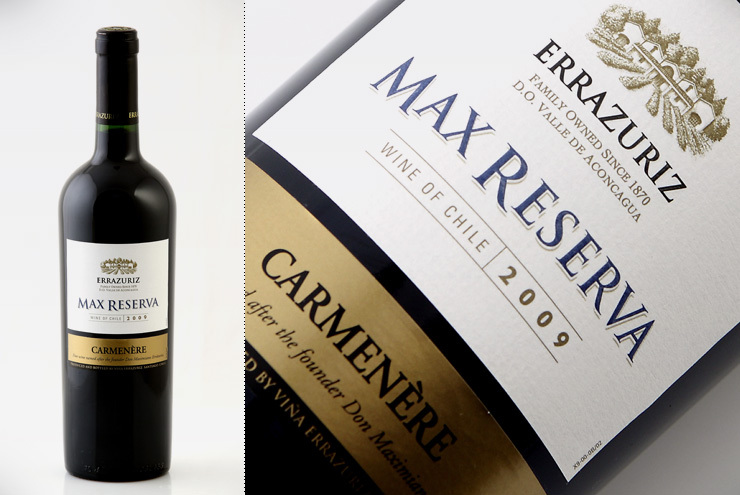If you ever feel like you need an anti-pinot noir, an antidote to somebody’s wine, my suggestion is drink a carménère. This is an unabashedly robust wine that has no intention of not being noticed, right to the next day when workmates will say rude things about your wine stained lips (if it makes you feel any better, Falstaff got the same grief from his employer).
Carménère is not my favourite grape and I don’t drink it all that often. The tannins are ever-present and can be hard on an empty stomach. The palate usually has a sort of chalky feel to it, as if it intends to paper over your tongue, and the primary flavour of the varietal is kind of like graphite.
In general I avoid the cheaper versions because all of these characteristics dominate. But there are an increasing number of people who adore this grape, and the sales have encouraged serious winemakers from Chile to work on it. Today’s carménère is considerably more civilized than the version you drank as little as five years ago, especially if you drift up the price ladder toward the $20 mark. If you’re really a fan of the stuff, there are an increasing number of flagship versions in stock. They are wonderful wines, but they’re also $60 or more.
I picked up a couple of 2010 medium priced wines and a couple of 2009 figuring this would make an interesting state of the art comparison. It was a remarkably tight spread that showed both the advantages of style and the varietal.
Torreon de Paredes is a smaller winery but well represented on the Prairies, being in both Manitoba and Saskatchewan. It is the least expensive of the set, and in percentage terms shouldn’t have been in the group, as it cost two-thirds what the most expensive cost. It showed a little. The tannins were slightly greener, with a bit of bell pepper in the bouquet. The oaking was also more aggressive and after a couple of days on the counter, the wine collapsed into that smooth caramel vanilla flavour set that is a give away for oak.
At this price it is well worth tossing a toonie on the counter if you’re drinking under the $14 mark, but if your house wine comes in closer to $20 this wasn’t enough of a deal to tempt me downscale.
Carmen Gran Reserva Apalta was the next cheapest of the set at just under $20. It had a radically different flavour profile from the other three, with the winemaker clearly wanting and producing a brighter palate. The fresher acidity of this one made it my favourite of the lot, and I found it worked better with food than the big carménère profile of the last two.
Carmen’s wine also had a very slightly herbaceous bouquet but the wine seemed more balanced to me. The tannins were the usual killer carménère type but somehow the winemaker had tamed them just enough that they didn’t seem the defining characteristic of the wine. It finished just a little fruity. Given the massive earth and mineral palate of carménère Apalta seemed delicate.
In the interest of full disclosure I should add that I am a fan of Carmen’s wines, and tend to prefer their Cab-Carménère blend, which may help you place your own preferences against my comments.
Errazuriz Max Reserva and Marques de Casa Concha are two labels I think of the same way. If you told me you favoured one over the other, I’d agree but really they are separated by the thinnest of margins. I like both of them a great deal.
In this case Max Reserva has a more mellow palate with a touch less acidity. The tannins struck me as a bit firmer, making it more of a steak-with-hollandaise wine, than just a mere grilled steak. It will probably suit the cocktail wine drinker if they’re committed to carménère.
Marques de Casa Concha was a bit brighter, with a slightly lighter palate than Max Reserva. I imagine they are trying to make a more elegant wine, that pairs more readily with food. It seemed more balanced to me, and was my second favourite of the tasting after the Carmen.
Which of these wines you plump for will ultimately come down to both mood and your individual preferences. I prefer wines that are a little bright compared to the average consumer. If you’re really seeking smooth, you’ll want the Torreon de Paredes. If you want elegance you’ll probably go with Marques de Casa Concha or Carmen Gran Reserva. If you like a glass of big red before dinner I imagine the Max Reserva is your best bet.
But the real point is not these four wines but the carménère section of the store. Try a few. If these are the kinds of wines that turn your crank, there are any number out there for you to explore. Lord knows how many you’ll find at Banville and Jones or Willow Park.
Carmen Gran Reserva Apalta Carmenere, Chile, 2010. $19.95 ****
Errazuriz Max Reserva Carmenere, Chile, 2009. $21.95 ****
Marques Casa Concha Carmenere, Chile, 2009. $23.99 ****
Torreon de Paredes Reserva Carmenere, Chile, 2010. $15.98 ****
___
James Romanow writes about Wine and all things Boozy for the Spectator Tribune. Follow him @drbooze
Follow us: @SpectatorTrib
